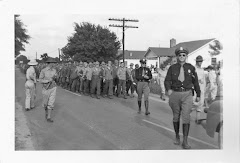

This blog is designed to share information from readers about German POWs in America during World War II and also about textile mill workers arrested by General Sherman during the Civil War. These two topics fit the common theme of people displaced by war.


 When I wrote Guests Behind the Barbed Wire in 2007, I knew that the German POWs in Camp Aliceville had had a puppet theater and wooden marionettes. I knew that they had staged puppet plays, but I had no names or personal stories to put with the few black and white photos.
When I wrote Guests Behind the Barbed Wire in 2007, I knew that the German POWs in Camp Aliceville had had a puppet theater and wooden marionettes. I knew that they had staged puppet plays, but I had no names or personal stories to put with the few black and white photos.
 Wilhelm Schlegel was born in Asslar, Germany in March 1918. He studied in Wetzlar and returned to his hometown to be hired as a bank clerk in 1937. Two years later, as Hitler plunged Germany into war, he was called up to six months of mandatory service in RAD, the German National Work Service. Then, as required, he joined the German army, received training in wireless communications and participated in military campaigns in Russia and France.
Wilhelm Schlegel was born in Asslar, Germany in March 1918. He studied in Wetzlar and returned to his hometown to be hired as a bank clerk in 1937. Two years later, as Hitler plunged Germany into war, he was called up to six months of mandatory service in RAD, the German National Work Service. Then, as required, he joined the German army, received training in wireless communications and participated in military campaigns in Russia and France. By May 1942, Wilhelm was in North Africa with the 4th Panzer Division wireless unit, and it was in North Africa, on the fertile Tunisian peninsula of Cape Bon, that he was captured by the British in May 1943.
Wilhelm arrived in Camp Aliceville near the end of the summer in 1943. He was assigned to Company 19 in Compound E. Although he left the United States after the war in March 1946, Wilhelm was transferred to French custody, and it was not until January 1948 that he was able to return home, resume his banking career, marry and raise a family. (See my book, Guests Behind the Barbed Wire (Crane Hill, 2007), for the rest of his story.)
Many years later, Wilhelm returned to Aliceville, Alabama with his family for reunions of the POW camp staff, prisoners, and townspeople. During visits, he often gave a speech about world peace and the value of freedom. He and his family became houseguests and fast friends of Chuck and Jane Gwin. Chuck is a banker in Aliceville, and the two men had much in common. The photo at left above shows a kindergarten class helping Wilhelm celebrate his 85th birthday at the Aliceville Museum. His grandson Philip enjoyed the company of the other children. In the background of this photo, you can see former Aliceville POW Hermann Blumhardt playing German and American folk songs on his accordion for the children.
This week, across the miles and the memories, and in among the legacies of war and peace, I received a wonderful New Year's e-mail from Wilhelm Schlegel. In addition to personal wishes for health and joy of life in the coming year, Wilhelm wrote the following (translation follows):
Wir leben in einer Zeit der Ungewissheit und bangen um den Frieden in der Welt , die nicht zur Ruhe kommt. Gerne denke ich an die Zeit in Aliceville und die lieben Freunde, die ich gerne wiedersehen moechte, zurueck--aber in meinem Alter sind die Strapazen zu gross. So lebe ich gerne mit guter Erinnerung an Alabama.
TRANSLATION: We live in a time of uncertainty and are concerned about peace in the world, which does not come. I think with pleasure about the times in Aliceville and the dear friends that I would like to see again. However, at my age, the strain would be too great. So, I live with my good memories of Alabama.
I, too, have good memories of Aliceville and of the many friends, both German and American, that I have met there and with whom I have shared good times and hopes for world peace.
With Wilhelm, I wish all of my readers herzlichen Gruessen und den besten Wuenschen for the year 2010.

 The photo at left shows "the last four positives" who were treated for diphtheria at Camp Aliceville in the fall of 1943. Although I have not identified all four German POWs in the photo, the man on the far right is Walter Felholter, who is quoted frequently in Guests Behind the Barbed Wire.
The photo at left shows "the last four positives" who were treated for diphtheria at Camp Aliceville in the fall of 1943. Although I have not identified all four German POWs in the photo, the man on the far right is Walter Felholter, who is quoted frequently in Guests Behind the Barbed Wire.
